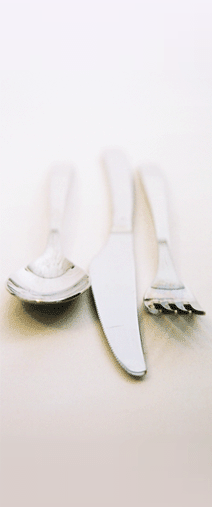Guillaume Chequespierre
August 25, 2011
10:55 AM
Friends Martine and Jean-Yves cane to stay with us last week and – knowing my fondness for a previous book of French Nursery Rhymes ; Mots D’Heures: Gousses, Rames – The D’Antin Manuscripts by Luis D. Antin Van Rooten.
-they brought for me another book by (I presume ) the same author called by the above title.
This contains not only many of that poet’s works like ;
Tout pille or, note, toute pille, date hisse de caisse tiens !
but also some specially selected works by others.
I particularly enjoyed the protest poem by the well known puritanical poet A. d’Enisonne against the modern obsession with writing about sex;
Art phallique, art phallique, art phallique en ouate
NB. To enjoy the full resonance of these extracts it may be necessary to quote the verses aloud and with a French accent.
1 comment.
My Two Apples, Eating
August 23, 2011
16:51 PM
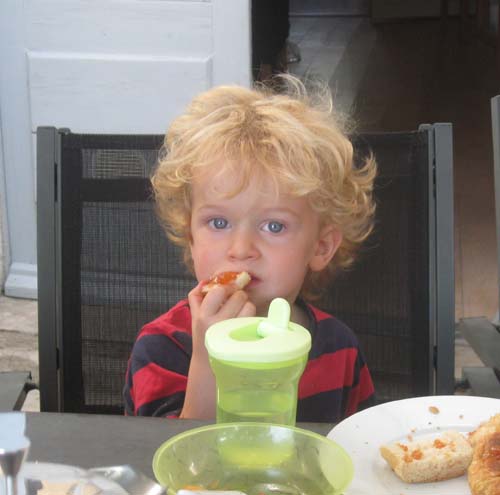
Fíonn, aged Two and a Half
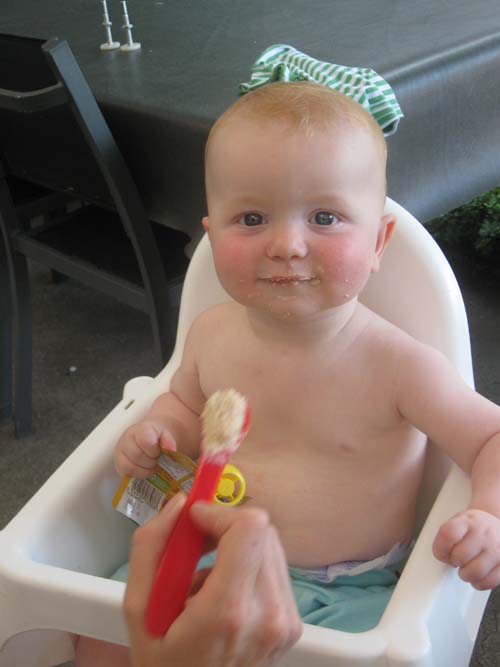
Ruadhán aged eight months
Figues
August 18, 2011
10:17 AM
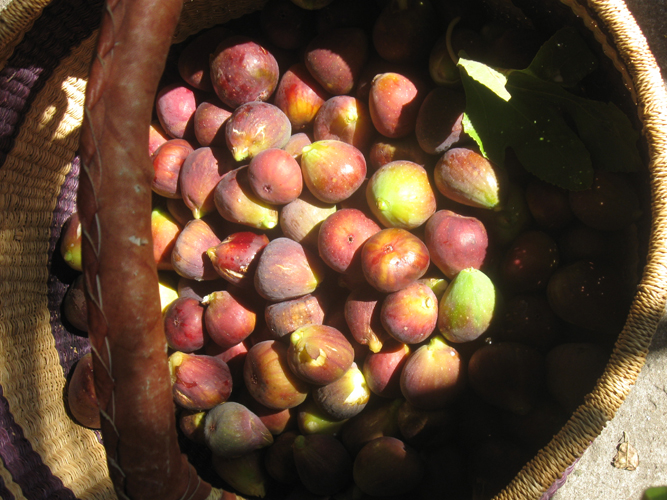
Met a couple at a dinner party last night who offered us the pickings of their Fig tree if we called around.
We didn’t have to be asked twice.
We got greedy and picked six kilos of beautiful sun warmed figs. We will have them with Bayonne Ham and Mozerella tonight and the rest (those I can keep from Síle) will go into jam.
1 comment.
Useless Bits of Information Two
August 16, 2011
10:48 AM
I was having a look at the Pages Blanche the French Telephone Directory on line yesterday, just checking up really that I was still the only Martin Dwyer in France (I am) when I began to wonder how many Dwyers (or O Dwyers) there were living in exile with me.
There are 33 in the whole of France.
Being one half Daly this was the next surname I tried , they do a lot better 1437 in France, there must be a French (or English) surname which is the same, or else what would explain this mass exodus from County Cork.
Intrigued at this stage I looked up Síle’s surname; Ronayne – not a one in France, but then spell it in the Irish fashion (as her father did), Ronan , and there are 176 of them.
Scrabbling at this stage for my French roots I looked up my Grandmother’s maiden name,Magnier, purported to be Norman and therefore from France.
I was rewarded, there are 3091 of my cousins still inhabiting their fatherland.
That led me perforce back to Waterford where everyone is called “Power” from the lowest right to the Marquis of Waterford himself.
They , like my Magnier cousins, claim to be of Norman extraction and to originally have been De Paor.
It appears they must have all sailed over with Strongbow as there are no De Paor’s at all left in France, ditto De Burca’s, as the Bourkes claim their aristocratic Norman ancestors to have been called.
The name Bourke does rather better , there are 596 in La Belle France and the Powers themselves , do better again , 684 of them, about the same as in Ballybricken.
4 comments
Michael Waterfield
August 14, 2011
09:40 AM
Under “People who inspire me ” on my Facebook Page I have selected three, two cookery writers, Elizabeth David and Jane Grigson, and a chef, one Michael Waterfield, whose restaurant I worked in the mid seventies.
Now it is not often that one is lucky enough to have one of ones hero’s visit as happened to me last week.
But first , by way of introduction read this piece I wrote in 2005 about my time in the Wife of Bath Restaurant in Kent :
The notion of gap years in a career was not totally invented by the present generation. After about two and a half years in our first jobs in Dublin, mine in Snaffles as a chef, Sile as a teacher in Basin Lane we decided to throw all up and head for the world outside while we still had the liberty to do so. We had a brief sojourn in France (and that’s another story) but ended up in London (which seemed quite as far away as Australia does today) in 1974 full of equal measures of fear and hope.
I had a letter of introduction to Margaret Costa, then cookery editor of the Observer and a godmother to my friend Stephen Pierce of Shanagarry. Her husband had a restaurant in central London called Laceys, very up market and very busy, they agreed to give me a try.
I lasted one night.
I blame neither them nor myself for that. My experience to date had been spotty in the extreme. I was badly in need of some further training before I could call myself a chef.
It was beginning to look like we would have to turn tail and try and creep back to Dublin and our former lives when we (i.e. Sile ) stiffened our backbones, gathered together our remaining funds and decided to give England a decent shot.
My restaurant guide bible at that time was (and still is) the Good Food Guide. We went through it with a fine tooth comb and picked out about 30 restaurants or small hotels where we felt we might fit in and learn something. We wrote them an honest letter, indicating that we were keen but little else and then sat back and waited to see if we would get any replies. Incredibly we got about 28 encouraging letters.
Most of them were very polite refusals, about ten were job offers of various sorts. Our confidence, which was just about at bottom, soared.
We picked out the two most tempting offers, one in Kent, one in The Lake District and made arrangements to be interviewed in both.
The Wife of Bath in the tiny village of Wye in Kent was our first interview.
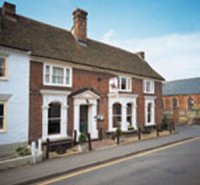
The Wife of Bath Restaurant
When we got there the door of the restaurant was answered by a scrawny lanky man in a very torn jumper who I assumed to be some sort of a gardener. Of course he turned out to be the proprietor, Michael Waterfield.
After talking to him for a few minutes I knew that I wanted to work here more than anywhere else. This man was, and still is, the most gentle, unassuming man I have ever met in a kitchen. As proprietor of a restaurant, which was at that time recognised as one of the top ten in England, he had none of the characteristics of a prima donna chef.
Michael ran his kitchen with kindness and understanding, he never raised his voice, didn’t know how to be sarcastic, and still produced marvellous food. He became, and still to this day is, my role model of how a kitchen should be run. He had a job for me in the kitchen and one for Sile working in the little bar taking the diners orders.
The Wife of Bath was called that after the character in Chaucer’s Canterbury Tales( we were very close to the Pilgrims Way) and also because Michael’s wife Hilary came from Bath.
Sile, being the sensible one insisted that we still should go to Grasmere to
the small hotel “Michaels Nook” where we had our second interview.
We had a long and torturous bus journey to Cumbria, and discovered when we got there that it would have been a most acceptable job but after meeting Michael Waterfield there was no competition.
We blew the last of our money by getting an express train back to London and arrived in Wye the following day, broke but looking foreword to our new life.
It didn’t disappoint us. We were to spend a most happy two years there.
As I said Michael was running one of the most renowned restaurants in England of the time. He had trained, like so many of his successful chef colleagues, under George Perry Smith in “The Hole in the Wall” in Bath.
Perry Smith is reckoned to be the man who translated the ideas of Elizabeth David into food for restaurants and was responsible for the huge raising of standards in catering in England, the reverberations of which can be felt in modern Britain’s culinary confidence and skill.
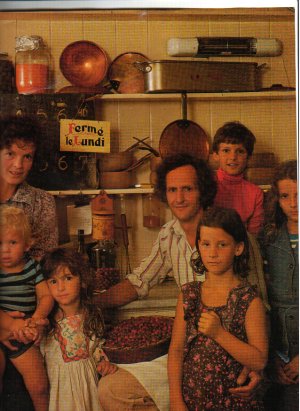
The Waterfield Family in the kitchen of The Wife of Bath
Pictured in Vogue Magazine in 1976
It was an exciting time to be in a kitchen in England, and Wye was a great village to live in.
The village was just a short train journey from Canterbury and about 90 mts by train from London. We actually could (and did) go to the theatre or cinema there and get the last train home. The Kent coast was about 30 mts away and Bob, the other chef, brought us to swim in Sandgate any hot afternoon when we were free.
Village life in England was a very new experience to us. For a long time we thought the villagers were cold and unfriendly. This was the time of the height of the IRA campaigns in England so we weren’t pushing ourselves forward anyway. By coincidence, at that time someone in Ireland sent us a copy of Hibernia magazine. There was an article in this written by an Englishman who moved to the west of Ireland who couldn’t get over how friendly (intrusive?) the natives were. The explanation was quite simple. English people thought it impolite to ask new comers about themselves, Irish people thought it impolite not to.
After 18 months in Wye our first daughter Caitriona was born and we were overwhelmed by the reaction of the villagers. They queued up at our door to bring presents, we bought absolutely nothing for the baby as everyone had hand me downs they were only too keen to give us.
We had been accepted and now they were only too happy to be friendly.
I doubt if we would have met with such kindness in a similar Irish village.
Thinking back on it all now I find it strange that I have no memory of ever being homesick while we lived in Wye. We made lots of friends there. Bob and his wife Janet were very kind to us and entertained us frequently and generously. We were much taken by the Waterfield family,
Michael kindly agreed to be Caitriona’s godfather, and Olga Wills, an Irish ex-pat like ourselves, agreed to be her godmother.
However it was the excellent , honest and simple food that is my best memory of our time in The Wife of Bath. While we were there Michael was updating his great Aunt, Janet Ross’s Italian cook book, “Leaves from a Tuscan Kitchen” for Penguin Books.

My very battered but much loved copy of “Leaves”
This wonderful little book on cooking vegetables was quite a revolutionary volume in the early seventies. It is amazing to see how it captures the simplicity of Italian cooking a full 25 years before the great success of The River Café.
The Wife of Bath was a very successful restaurant, we used to entertain the then prime minister Edward Heath quite often and on one historic occasion had Elizabeth David herself for lunch.
After two years we felt the time was right for us to come home so, in March 1977 we packed all our hand me downs together and sailed with Caitriona on the Inisfallen back to Cork. Our time abroad was only ever intended to be a few years, we knew that we wanted to bring up our children in Ireland but still we left Wye with real regret.
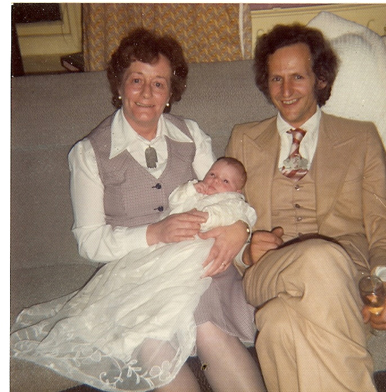
Olga Wills and Michael Waterfield with Caitriona at her Christening party in 1976
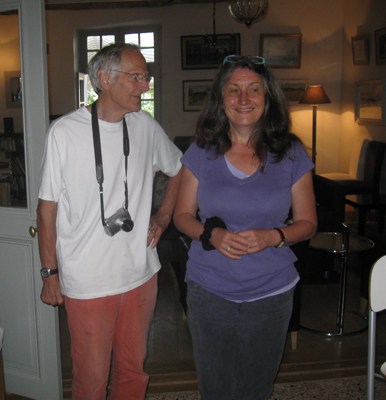
Michael and Julia Waterfield in Le Presbytere last week.
Some time last year I determined that having totally lost contact with Michael I was going to try and regain links.
I knew he had sold the restaurant shortly we left in 1997 , I also knew he had opened a restaurant in Canterbury (where he had made a chef out of Sam Clarke of Moro Restaurant in London) but then he had disappeared.
I Googled his children’s names and found that a reporter on the Daily Telegraph was called Bruno Waterfield and indeed was Michael’s eldest son.
He put us in touch again and Michael was as delighted as I was with the contact.
Hearing about our new venture he booked to come and stay with us in Languedoc this Summer and arrived and stayed last week.
He and his new wife Julia , Síle and I had dinner on the terrace together last thursday , fortunately there was nobody else in the house as the night was spent filling in the thirty four and a half years it was since we had last met- a pleasure I think for all of us.
A rare gift that, to be allowed to play host to ones hero.
(Incidentially Leaves from a Tuscan Kitchen has been reprinted and re-issued by Grubb Street Press and no serious kitchen should be without it.)
2 comments
Ellpees
August 11, 2011
23:24 PM
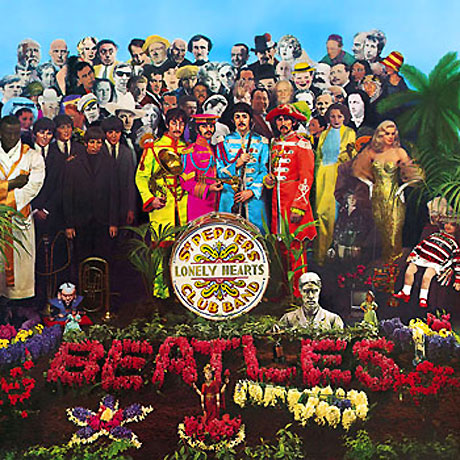

Okay, which one is (do you think) the best.
La Reine Claude
August 9, 2011
15:48 PM
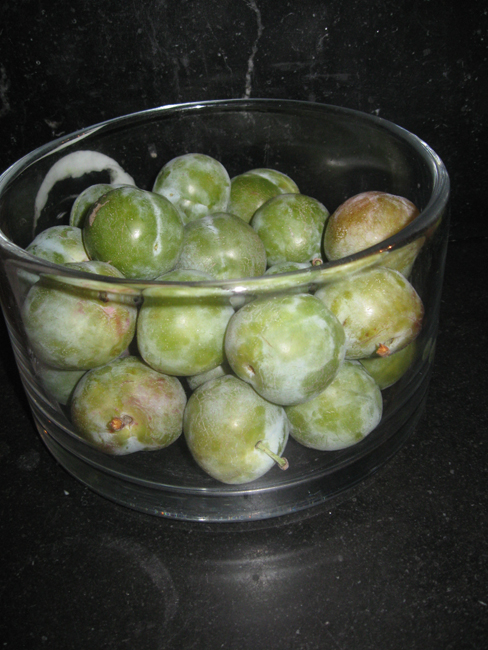
It is a bitter sweet moment when La Reine Claude- The Greengage- arrives at the market in France.
Bitter because it is the very last of the soft fruit and signals that in the next few weeks the supply of local Apricots, Peaches , Nectarines, and – eventually- plums will cease and we will be faced with a long winter of imported fruit and dried fruit.
But it is sweet because these beauties- called in France after the wife of Francois 1 under whose reign they were first cultivated into France – are the sweetest of all the plums , balls of juicy sugar and make a delicious jam.
In The Oxford Companion to Food Alan Davidson quotes 19th Century gardener Bunyard’s description of the greengage ;
“If there is a better gage than this I know it not, and certainly there is none so beautiful. Its French name Reine Claude Diaphane exactly describes its clear transparent look ; a slight flush of red and then one looks into the depths of transparent amber as one looks into an opal , uncertain how far the eye can penetrate ”
Well yes, Um, My thoughts exactly.
Bedroom Chairs
August 8, 2011
14:11 PM
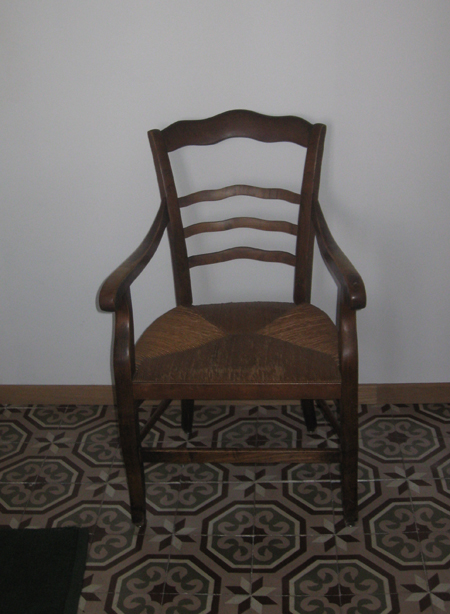
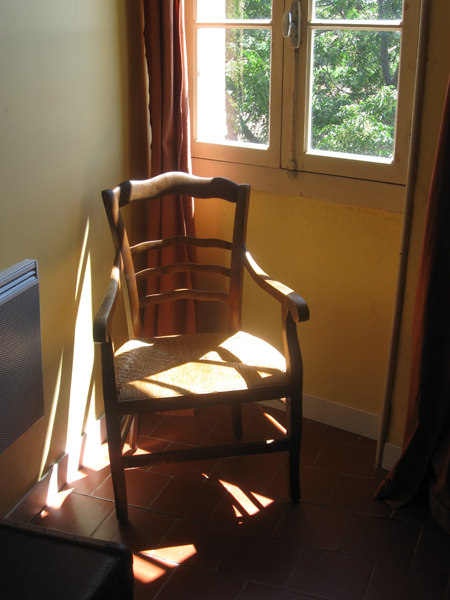
For the last couple of years we have been on the look out for some chairs for two of the bedrooms.
We wanted to provide chairs where people could sit with some comfort.
There were , we discovered a lot of restrictions.
A large overstuffed armchair would be totally out of keeping and would dominate the room. It had to be something almost transparent , like those known as fireside chairs in Ireland, but it also had to be both of the region and -like the rest of the bedroom furniture , have a bit of age.
The final, and it turned out , most difficult problem was that these chairs would have to be affordable.
We looked just about everywhere , saw a lovely settee (like two of those pictured joined together) but it was a prohibitive €1500.00.
We investigated buying a Lloyd Loom armchair from England (not of the region but a l’epoque) only to discover that these were also outside our price range. Any of the other modern cane chairs which we looked at seemed coarse and out of place.
Last Friday at a Brocante Fair in Florensac we spotted these two beauties .
We decided we would be prepared to spend a hundred Euros on the pair.
Madame was looking for €150 , we struck a deal at €120, I think we were all satisfied.
They were, we had noticed, carrying a fair share of woodworm and had been altered sometime in their past, an apron put where a bar had been.
But, they were comfortable , distinctly old (my guess would be the begining of the twentieth century) and surprisingly comfortable.
Clive -the guru- always told us not to be afraid of woodworm “It’s treatable”
so Síle spent Sunday squirting woodworm killer into the little holes and then, this afternoon we gave them a room each.
I think they are perfect.
Now we need another two to complete.
1 comment.
How to Clean a Bathroom
August 8, 2011
11:39 AM
First statement is that this is not about cleaning a bathroom but about cleaning a shower room. I am using bathroom in the American sense, where only the super-rich have baths. In our Chambre d’Hote we have a shower room with each bedroom, the following lesson is how to clean one.
When I started in the chambre d’hote business I had had no experience whatsoever of cleaning bathrooms or bedrooms , fortunately I had married well.
My wife earned some crusts cleaning bedrooms in the Lancaster Gate Hotel in London during her student days and, when we both worked in Anjou in the seventies in the Chateau de Teildras she had also worked at the bedrooms there.
It was there that she discovered that in this seemingly shabby old manor house Madame La Comtesse had extremely high standards of both hygiene and appearance. The taps, for instance, had to be cleaned, dried and then polished before any guests were allowed in.
One of my Madame’s first statements when we opened Le Presbytere was to declare her own mission ststement for the cleaning, she believed that : Every guest should feel that they were the very first person to use their bathroom.
Normalement the division of labour divides fairly between me doing the cooking and the downstairs and Madame the cleaning of the bedrooms but every so often the balance changes , as at the moment when there are four bedrooms to get ready but no-one to feed , and so I get co-opted as cleaning assistant.
Now Madame, who has a fairly low opinion of my cleaning abilities, took me through the exact method of cleaning a bathroom before she let me try one and she then examined it minutely after I had finished.
Strictly in the interests of science I am going to let you into the method I have to employ.
I head for the bathroom with a bucket containing a 2 large cleaning cloths and three other drying ones, a green scrubby sponge, several old toothbrushes to search out hidden dirt, and two different sorts of cleaning product, one made with raspberry vinegar which is anti limescale and one made with Eau de Javel which is a fairly powerful bleach.
First job is to thoroughly Hoover the bathroom, including the shower.
Next object of my attention is the toilet which is thoroughly scoured with the scrubby and the Eau de Javel. Then it is rinsed all over with washcloth#1, dried with washcloth#2 and then the chrome bits polished with drycloth#1.
Next to be tackled is the shower, now perhaps I should digress at this moment and talk about the cleaning uniform.
Basically the very best uniform for cleaning bathrooms is none at all, do it naked . Cleaning of the shower always involves me in at least one soaking when I hit my butt off the tap and drown myself.
However if, like me you suffer from the terror of being surprised cleaning in the nude, the second best option is to do the job in discardable clothes. I have destroyed far to many “good” clothes with bleach to risk them.
I do the job in an ancient tee shirt and an equally ancient pyjama bottom.
Back to the shower.
Out now comes the anti limescale product.
This is sprayed all over the inside of the shower, then out comes wet cloth#3 and the shower is washed all over. The shower comes, at this stage, into its own as it is used to rinse itself thoroughly. Then out come drycloth #2 (now damp cloth ) and all the surfaces are dried. Then enter drycloth #3 and the chrome bits, the soap racks and the showerdoors are dried and polished.
Last job in the shower is to kneel outside and perform all these ablutions on the floor.
Then the exact same set of washing protocols are practised on the sink.
Then it is just a matter of cleaning off the wall tiles, the mirror and the towel rails before a final wash of the floor and then one just has to wait for Madame’s final inspection to discover if it could be declared guest ready.
( And I bet you all thought I was having a great time out here )
2 comments
Useless Bits of Information One
August 6, 2011
12:42 PM
As a self confessed nerd I have lately formed a notion to tell people when I have acquired some of these useless facts.
Here is the first.
In the smallest room in our house I have taken to keeping the complete works of Shakespeare.
As I dip into various plays it has struck me that Englands greatest playwright did not set all of his plays in his native country – au contraire.
So, being a nerd, I decided to write down just where he set his plays (you will find that the countries add up to more that his number of plays, this is because I allow a place setting if part of the action happens there.)
He did in fact set more plays in his native island than anywhere else, but only just.
He set fourteen in the UK (including Scotland and Wales one each) but he set a staggering thirteen in Italy making it his technical favourite.
Next favourite is France with seven , closely followed by Greece with five.
After that he scattered his settings throughout Europe .
He set one in Austria , one in Denmark (no prizes) part of one in Czechoslovakia , part of one in Cyprus , another bit of one (again no prizes) moves the action to Egypt.
Then there are two serious problems , Pericles is set “dispersedly in various countries ” and The Tempest is on “An Island ” .
But despite our long claim of him being an honorary Irishman he set none in Ireland.
|
